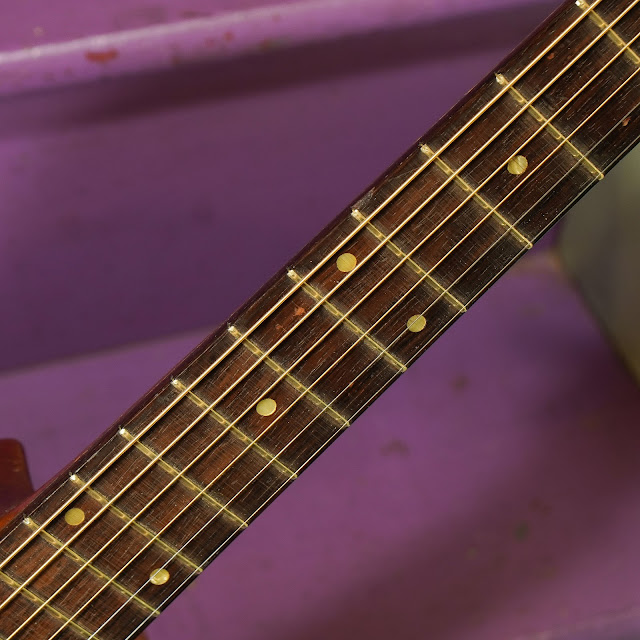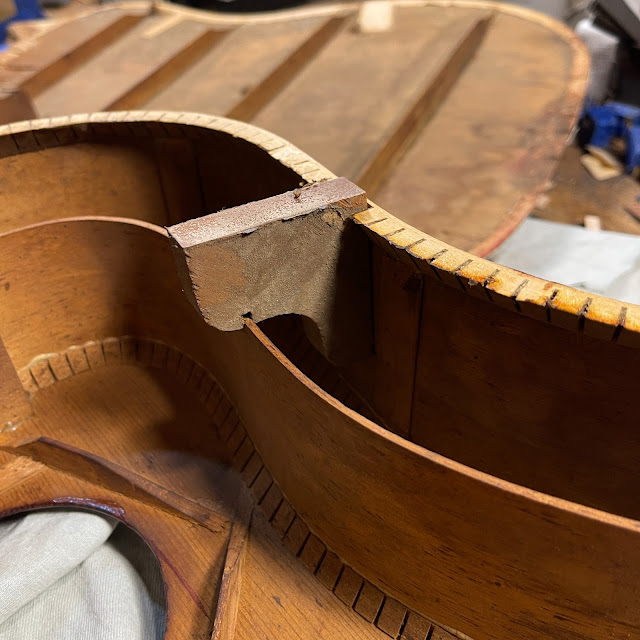1930s Gibson HG-20 Flattop Guitar
Update 2023: the owner couldn't get used to the neck on this guy (he likes those slim-n-quick '60s ones!) so it's back here for resale. The only difference between the photos and the guitar right now is that it has StewMac repro-style vintage-looking tuners on now -- I'll add a photo of them when I get a chance.
This long-suffering guitar is an HG-20 from the early '30s. It was originally a Hawaiian model intended for face-up, on-the-lap, Hawaiian-style slide playing. The f-holes in the top are there because the original configuration of the guitar features interior sidewalls glued to the top and an isolated middle part of the top where all the sound is generated. The idea is that the sound is generated in the middle, is "pushed out" to the back of the guitar, and then reflected out the f-holes much like a resonator on a banjo functions.
In reality, what happens with the sound of a guitar built this way is that it just gets really bright and spanky-sounding and very directional. It's why so many of the clips you see of these guitars (as standard-issue) on the net favor fingerpicking and country-blues style playing which suits that nasal sort-of sound.
The owner of this guitar found it in a refinished, back-held-on-with-tape, destroyed sort-of state -- lacking a bridge, too, and just really hard-up. He bought it and sent it up here ages ago to get all of its original bracing yanked-out and modernized. It felt like only a slight crime because of the state of the rest of the guitar, but a good crime nonetheless. I have photos of the process towards the end of this post for those interested in seeing the before and almost-after. I never did snap a shot with everything finished under the hood!
I decided to rebrace it in a pattern that reflected the original bracing style but also my own tastes. I've been using laminated braces for a while, now, using my supply of 200-year-old, tight-grained Douglas fir and laminating a thin strip of carbon fiber to one side of it. I then cut the braces almost rectangular and low in shape (similar to Bohmann bracing) and plop it down in whatever pattern I like. The benefit of the carbon fiber reinforcement cannot be overstated -- it's like night and day. The tops remain true and stable in use, one can lighten-up the bracing like crazy, and sustain is increased by a lot compared to bracing without it. It's like a steroid boost for the guitar, frankly.
Of course, aside from that bracing work (which was tedious -- especially removing the old neck/endblock extras), there was other work to do as well. I made and installed a repro-style (sort-of) bridge from Madagascar rosewood and fit a straight saddle slot to it. This is because the owner is a lefty but I like to make his guitars easily-convertible to righty in case he wants to swap toys with other boys. In this case the original bridge would have had a straight saddle for the Hawaiian setup anyway, so it's sort-of appropriate. I just use a wider saddle to get the compensation right for either setup. The guitar has both a lefty and righty saddle included with it.
The remaining work was fret level/dress and setup-side stuff. The tuners on it right now are not the ones it's going home with -- those will be StewMac repros when they arrive in the mail. These were just to get it strung-up and running. Update: this now has that set of StewMac tuners on it.
If you watch the video, at one point I cover the f-holes with blue tape so the top "acts" like a traditional top. The tone changes somewhat dramatically from the voice it has "as normal" (which is very close to something like a much-louder, much-ballsier '50s LG-2 -- click for what I mean) to something more like a '40s LG-2 with a little more girth (click here for what I mean by that). The extra bass response is addicting at first but when you take the tape back off and hear its normal voice, the straight-up punch, volume, and clarity is addicting as well. I still can't decide what I like better but I think the normal voice is more interesting if you've already got a "traditional Gibson" voice in your arsenal.
Oh, and right -- the body looks like a J-35 but it specs-out more like an LG-size/00-size body. Also, brownie points go to whoever ballpoint-penned the Gibson logo back into the headstock after the refinish. So funny...
Repairs included: rebrace and associated work, new bridge, fret level/dress, setup, etc.
Top wood: solid spruce
Back & sides wood: solid maple sides, ply maple back
Bracing type: acute, long-x-bracing with single tonebar
Bridge: Madagascar rosewood (replacement)
Fretboard: rosewood
Neck wood: mahogany
Action height at 12th fret: 3/32” bass 1/16” treble (fast, spot-on)
String gauges: 52w-12 custom lights
Neck shape: medium-full soft V
Board radius: 10"
Truss rod: adjustable (and, amazingly, works just fine)
Neck relief: straight
Fret style: medium-low
Scale length: 25 1/8"
Nut width: 1 3/4"
Body width: 14 5/8"
Body depth: 4 1/4"
Weight: 3 lbs 13 oz
Condition notes: Please just look at the photos -- refinished, tons of repaired side cracks (I added a bunch of cleats/reinforcement strips to the sides for good luck), delaminated ply chip-outs on the back, non-original bridge, new nut and saddle, new pins all around, top completely rebraced, and funk everywhere -- a number of repaired cracks at the lower-bout f-holes, too. The fretboard is actually a later-era, '50s or '60s, Harmony-made replacement (still Brazilian rosewood). I'd already shipped the guitar home when I realized that was why the scale length was not "Gibson-y."
It comes with: ...90 years of sweat and tears and beers spilled all over it.
Here are the new braces installed -- in my now-customary lower/squarer shape but before final sanding/shaping. Carbon fiber reinforcement lets you go pretty thin without compromising stability.
The patchy repairs to the damaged f-holes got sanded and cleaned-up a bit better, too, before regluing the back.





























Comments
So when I walked in on Jake’s workshop and this guitar was on the operating table with its back off, I was astonished. I was aware of these guitars, having seen them in books, but never saw one in real life, let alone with its back off. It confirmed for me that Gibson’s basic concept of a guitar-inside-of-a-guitar seemed like a pretty terrible idea, but moreover, this poor guitar was really in terrible shape. The amount of filth, damage and the ravages of cruel time were abundantly clear.
So Jake’s rebuild was a fascinating process. I love the ball point logo too…
Oh, and the guitar is strangely cool too.